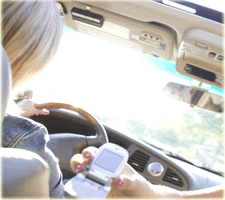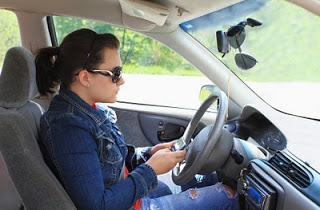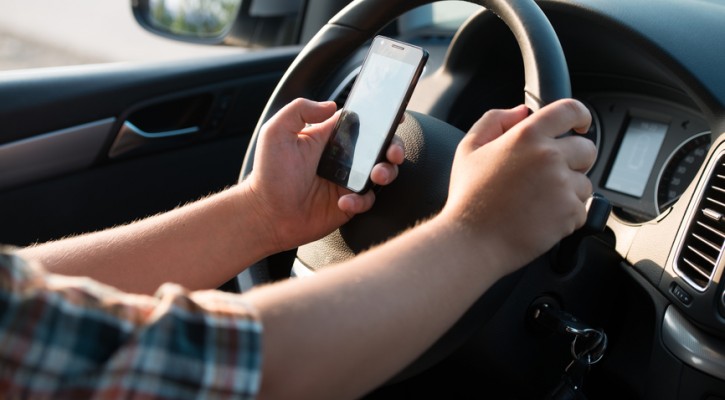Category Archive: Mobile Phones

What is being done to Stop Distracted Driving?
October 12, 2010
Each day there is more research conducted, articles written and information available about the dangers of distracted driving. This increase in awareness is highlighting the growing problem all drivers face on the roadways. Distracted driving has been estimated to cause over 11,500 deaths in the last two years. But what has been done to eliminate the problem? What initiatives are organizations and individuals doing to combat distracted driving?
Forming Organizations
When you Google “distracted driving groups” you will find varied results of individuals banding together to increase awareness on distracted driving, on a local or country-wide basis. The organizations can be as simple as asking people to pledge against distracted driving, like Oprah’s No Phone Zone, or wearing thumb socks to show a driver’s support for not texting while driving. These groups establish their presence online, in various social networking services, making it easier to distribute the message.
Enacting Laws
With the nationwide awareness on the shocking statistics of texting while driving, the Federal, state and local governments and municipalities have proposed and enacted laws to prohibit cell phone usage while on the road. So far, more than 30 states have a law that places a ban on texting while behind the wheel, urging drivers to think twice before they pull out their phones. The type of penalties and amount of fines range from location to location. Currently, the options are being weighed on how to effectively further enforce texting ban laws.
Phone/Text-blocker apps
How to stop phone use while on the road? Simple. Install a phone/text-blocker application. These applications interface the cell phone to the vehicle’s Global Positioning System (GPS) to see if the car is in motion. If so, the application disables the cell phone’s call and/or texting features. With crash-risk increasing four times/talking on the phone and 23 times/texting, it can help discipline the driver into not relying on their phones so much while on the road, until they break the habit.
Mock Crashes
Several local/teen driving advocacy groups have set up mock crashes to remind teen drivers (the group most likely to engage in texting while driving) what could potentially happen if they text and drive at the same time. In most places, the mock crashes are set up at the entrance of the school depicting the wrecked cars, actors as teen drivers, playing dead with phone in-hand. It is a shocking, yet accurate statement that reminds teen drivers of the potential consequences.
Trial Runs
There are also trial course runs, usually hosted by a state’s Division of Motor Vehicles along with several advocates against distracted driving. They allow drivers to experience firsthand what could happen should they attempt to text while driving. Set in an enclosed space, with only traffic cones as obstacles and are operated at low speeds. These courses are designed to show drivers that they are unable to handle both tasks, by challenging them to maneuver their vehicle safety and skillfully while driving distracted.
Advertising and Videos
Various organizations release ads that are either funny or serious in order to make their point. Some organizations do their advertisements a step above by involving the people themselves. They create contests asking drivers if they have what it takes to get the message across, in a video format. The advantages of these types of contests include maintaining a limited budget, creating enthusiasm, spurring creativity and raising safety awareness in teen drivers.
People are motivated to change their behavior in different ways. One or all of these approaches can be incorporated to stop distracted driving. Take a proactive approach to know the dangers and help stop distracted driving.

Distracted Driving Campaigns
July 9, 2010
Buzz, buzz…it will just take a second to check. Ring, ring…it could be important. Yeah, I should go ahead and make that call. It will save me the time and hassle later on. The temptation to reach out and/or respond to some one through a cell phone is great. You have heard the news stories and safe driving campaigns and you know that you shouldn’t, but…do you resist the urge to use the cell phone or let temptation get the best of you?
In order to completely eliminate the urge to use your phone you could turn it off before turning your key in the ignition, lock it up (in the glove box, console, or trunk), or install some of the new technology for cell phones. There are several companies offering services that will restrict the phone’s ability to send and receive text and email messages. Some companies offer services that will restrict calls too. A sampling include:
Textecution – http://www.textecution.com
Textecution is an application designed for parents to install on their children’s phones. It utilizes the GPS features of several handsets to determine if the owner of the phone is moving at more than 10mph. It disables the texting function of the phone. If the person with Textecution on their phone is riding a vehicle as a passenger, or in a bus or train need to use the text feature, there is an “override” option — requesting for text access from the administrator. The parent who installed the phone is designated as the administrator, and can allow, temporarily for the phone to allow texting features. www.safefloridadriver.com
iZUP – http://www.getizup.com/
iZUP disables your phone entirely, removing any distraction from the road. It automatically forwards calls to voicemail and holds text messages while the phone is in motion. It is also time-delayed, to prevent reactivation of the phone’s features in natural stopping areas, like stop lights. The phone will only allow the user to make calls to 911 and 3 pre-approved numbers.
TXTBlocker – http://www.txtblocker.com/
TXTBlocker utilizes GPS locations to detect if the phone is traveling at a car’s moving rate and disables features of the phone accordingly. The installer of the TXTBlocker phone can also designate which areas are no-phone zones, and deactivates texting, calling, email and browsing. There’s also a feature that auto sends a text message to the parent, should the phone be moving at speeds greater than 65mph. Another safety feature for parents is they could check where the owner of the phone is in, based on GPS location. The phone will still be able to dial 911, in case of emergency. It only checks in with GPS every few minutes, so it doesn’t constantly use the phone’s battery.
DriveSafe.ly – http://www.drivesafe.ly/
DriveSafe.ly is a hands-free application that reads out text messages and emails as the phone receives it. There is an optional auto-responder that sends out a customized text message while the application is active.
Committing to be distraction free when you are driving is not easy. But the statistics remind us each day that we are more likely to have a collision when we are distracted, many drivers are making an effort. Regardless of whether it is hand held or hands free, the cell phone is a distraction for every driver.
Learn more about the Measures Taken to Stop Distracted Driving.

Measures Taken to Stop Distracted Driving
May 5, 2010
Each day, as it seems, more and more information about the dangers of distracted driving comes out — which increases the awareness of drivers about the growing problem. But what has been done? What exactly are organizations and individuals doing to combat distracted driving?
Forming Organizations
When you Google “distracted driving groups” it will yield several results — of individuals banding together, increasing awareness on distracted driving, on a local or country-wide basis. These can be as simple as asking people to pledge against distracted driving, like Oprah’s No Phone Zone, or wearing thumb socks to show a driver’s support for not texting while driving. These groups establish their presence online, in various social networking services, making it easier for their targets to get the message.
Enacting Laws
With the nationwide awareness on the shocking statistics of texting while driving, local governments have acted to put in motion laws that would prohibit cell phone usage while on the road. So far, more than 30 states have a law that places a ban on texting while behind the wheel, urging drivers to think twice before they pull out their phones, unless they want a penalty. For now, the options are being weighed on how to effectively enforce texting ban laws — but public support usually wins, and a law is enacted.
Phone/Text-blocker apps
Stopping phone use while on the road? Simple. Install a phone/text-blocker app. These applications interface the phone to the car’s GPS and if it sees that the car is in motion, the app disables the phone’s features. With crash-risk increasing 4 times/talking on the phone and 23 times/texting — it may help discipline the driver into not relying on their phones so much while on the road, until hopefully, they won’t have a need for such an application anymore. Learn more about apps like this including http://www.Textecution.com/.
Mock Crashes
Several local/teen driving advocacy groups have set up mock crashes to remind teen drivers (the group who are most likely to engage in texting while driving) what could potentially happen if they text and drive at the same time. In most places, the mock crashes are set up in a way that, the first things that teens going to school are going to see are wrecked cars, teen-drivers-playing-dead-with-phone-in-hand and lots of fake blood. It is a shocking, yet accurate statement that would inform teen drivers of the potential consequences.
Trial Runs
There are also trial runs — usually hosted by a state’s DMV along with several advocates against distracted driving — they allow drivers to experience firsthand what could happen should they attempt to text while driving. Set in an enclosed space, with only traffic cones as obstacles, there are only a few who manage to get through the course without hitting any of the cones while texting/driving. There are drivers who believe they are perfectly capable of handling both tasks, but running through a trial distracted driving course more or less proves them otherwise.
Ads
Various organizations would release ads that are either funny or serious in order to make their point. Some organizations do their advertisements a step above by involving the people themselves — they create contests asking drivers if they have what it takes to get the message across, in video form. Which is a good thing — it awakens an enthusiasm and awareness in teen drivers — which makes them think about safety when driving.
Distracted Driving Courses
The addition of cell phones, texting and driving, in-vehicle video entertainment, and navigation systems lengthens the long list of driver distractions. Research reveals that many new drivers do not recognize the risk of these activities when driving. To make teen drivers more aware of the risks there are courses like Dangers of Distracted Driving. The course creates a clear understanding of the distractions while driving and how they can cause crashes and cost lives.

California Jumps on the No Cell Phone for Teen Drivers Bandwagon
September 28, 2007
Governor Arnold Schwarzenegger terminated teen drivers’ rights to talk on the cell phone and drive at the same time through the signing of a bill that will go into effect in July 2008. This bill involves teen drivers under the age of 18 and states that no cell phone use is allowed period while behind the wheel of the car.
There is another bill that is also going into affect at the same time that involves another cell phone and driving situation. In this instance, drivers age 18 and up can use a cell phone but only if it is a hands-free device. No texting and no hand held phones are allowed. The bill restricting the total use of cell phones for teens is in response to collected data that shows inattention of teens are the primary cause of accidents.
While the two bills are nice in theory, there are a few problems with them as well. First of all, how are these going to be enforced effectively? A cop could see a driver going down the road with a cell phone to their ear talking and flash his lights to alert the driver to pull over. Any smart driver would ditch the evidence quickly out of sight to make it a he said/she said scenario. How exactly can the cop prove that the cell phone was in use at the time?
Another thing, the fines for someone getting caught breaking these new upcoming laws are laughable. How exactly are $20 and $50 fines going to be much of an incentive for teens as well as older adults affected? Unless they are habitual offenders and have the worst luck at being caught, these fines are nothing more than a shoulder shrugging, “oh well.”
These laws about cell phone use and driving should be viewed as a first step of many to curb teen accidents and fatalities on the road. While the laws may have trouble being enforced, the essence of them is important. Now the teens know that there are consequences and could have the possibility of having their driving privileges and cell phone taken away from them by the parents. That is what teens are truly afraid of, not being ticketed for it, because some kids have that money as pocket change and can pay the fine without a parent even knowing about it.
The bottom line is that these laws will make the teen pause while driving and decide whether that phone call or text message is truly important. Making teens stopping to think about the consequences of their driving behavior is usually half the battle. The other half is actually the law and parents enforcing the consequences of teen driving behavior.

Florida Police Officers Worry About Distraction and Safety
April 27, 2007
As the parent of a teenage driver, Police Chief Roger Boatner, of Lakeland, Florida worries when his daughter is behind the wheel. However, his worries are not with her own driving skills or with the locations she visits. He worries most about the many drivers he sees doing nearly everything but driving as they cruise down the street.
Those who spend even a few seconds changing a CD, answering the cell phone, or taking a bite of a sandwich can cause a serious accident. Other troopers agree with the seriousness of the problem of distracted driving. Larry Coggins of the Florida State Highway Patrol claims that in every crash there can be some type of driver error found.
Many studies have been done on the effects of cell phones and other distractions while driving. While exact numbers have varied, the basic results have been the same.
- Virginia Tech’s Transportation Institute found that drivers who talk on cell phones are 4 times more likely to be involved in a serious crash.
- The National Highway Traffic Administration carried out a study, which found that more than 75% of crashes and 66% of near misses occurred when drivers were engaged in conversations on cell phones.
- The University of Utah carried out an experiment that resulted in the conclusion that drivers talking on cell phone were just as impaired as an intoxicated driver.
Results such as these have caused a few states to pass laws prohibiting all drivers from talking on cell phones while behind the wheel. Even more states have implemented similar laws, but focused them only on teenage drivers. Unfortunately, Florida is yet to have created one of these laws.
The Sheriff’s Office in Polk County, Florida has decided that these messages are so important that they have placed them on their phone system as a hold message. Additionally, they remind drivers of the importance of wearing their seat belts.
The Polk Sheriff’s Office handled 50 traffic deaths within their jurisdiction. Of these, officers believe that at least 14 lives would have been saved if the victims had been wearing a seat belt. To prevent more of these accidents from claiming the lives of young people, Florida has enacted a law allowing officers to pull cars over if passengers under the age of 18 years old are seen unrestrained.
